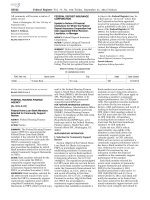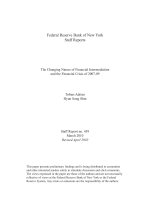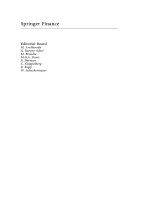Regulatory framework of financial institutions
Bạn đang xem bản rút gọn của tài liệu. Xem và tải ngay bản đầy đủ của tài liệu tại đây (3.46 MB, 149 trang )
DR. LUBINDA HAABAZOKA
REGULATORY
FRAMEWORK OF
FINANCIAL INSTITUTIONS:
A ZAMBIAN PERSPECTIVE
Download free eBooks at bookboon.com
2
Regulatory Framework of Financial Institutions: A Zambian Perspective
1st edition
© 2016 Dr. Lubinda Haabazoka & bookboon.com
ISBN 978-87-403-1431-1
Peer review by Dr. P. Kamanga, Lecturer and Head of Department – Business Administration
and Marketing, Copperbelt University, Kitwe, Zambia
Dr. S. Kapena, Senior Lecturer and Dean of the School of Business, Copperbelt University,
Kitwe, Zambia
Prof. T.K. Taylor, Professor and Dean of the School of Graduate Studies, Copperbelt
University, Kitwe, Zambia
Download free eBooks at bookboon.com
3
REGULATORY FRAMEWORK OF FINANCIAL
INSTITUTIONS: A ZAMBIAN PERSPECTIVE
CONTENTS
CONTENTS
Preface
7
1
Overview of the Financial System
8
1.1
Introduction
8
1.2
Structure of the Financial System
8
1.3
Financial System Boundaries
11
1.4
Revision Questions
13
2
Overview of Financial Institution Regulation
14
2.1
Introduction
14
2.2
The Priciples of Regulation
14
2.3
Regulatory Structure
16
2.4
Revision Questions
29
3
Central Bank Regulation
30
3.1
Introduction
30
3.2
Rationale ¢ Central Bank Regulation
31
3.2
Central Banking Around the World
33
www.sylvania.com
We do not reinvent
the wheel we reinvent
light.
Fascinating lighting offers an ininite spectrum of
possibilities: Innovative technologies and new
markets provide both opportunities and challenges.
An environment in which your expertise is in high
demand. Enjoy the supportive working atmosphere
within our global group and beneit from international
career paths. Implement sustainable ideas in close
cooperation with other specialists and contribute to
inluencing our future. Come and join us in reinventing
light every day.
Light is OSRAM
Download free eBooks at bookboon.com
4
Click on the ad to read more
REGULATORY FRAMEWORK OF FINANCIAL
INSTITUTIONS: A ZAMBIAN PERSPECTIVE
CONTENTS
3.3
Functions of Central Banks
36
3.5
The Bank ¢ Zambia Act
38
3.6
Revision Questions
41
4
Commercial Bank Regulation
42
4.1
Introduction
42
4.2
Overview of Commercial Banking
43
4.3
Objectives of Commercial Bank Regulation
46
4.4
Formation and Registration of Commercial Banks
47
4.5
Prudential Supervision of Commercial Banks
51
4.6
Taking Possession of Banks and Financial Institutions
56
4.7
Insolvency Dissolution and Liquidation of Banks And
Financial Institutions
58
4.8
International Aspects of Commercial Bank Regulation
60
4.9
Revision Questions
68
5
Insurance Industry Regulation
69
5.1
Introduction
69
5.2
Overview of the Insurance Industry
69
5.3
The Legal Framework and Regulatory Body
70
5.4
Formation and Registration Insurers
73
5.5
Regulation of Management and Shareholding of Insurers
74
5.6
Transfer of Insurance Business
77
5.7
Winding Up of Insurers
82
5.8
Revision Questions
83
6
Pension Fund Regulation
84
6.1
Introduction
84
6.2
Role of Pension Funds in an Economy
85
6.3
Legal Framework for Pension Fund Regulation
86
6.4
Registration of Pension Funds
88
6.5
Prudential Regulation and Supervision of Pension Funds
91
6.6
The Role of the Pension And Insurance Authority in the Regulation
of Pension Funds
94
6.7
Deregistration of Pension Funds
97
6.8
Revision Questions
98
Download free eBooks at bookboon.com
5
REGULATORY FRAMEWORK OF FINANCIAL
INSTITUTIONS: A ZAMBIAN PERSPECTIVE
CONTENTS
7
Regulation of Building Societies
99
7.1
Introduction
99
7.2
Overview of Building Societies
100
7.3
Formation and Registration of Building Societies
100
7.4
Regulation of Building Society Management
104
7.5
Roles of the Registrar and Minister of Finance in the Regulation
of Building Societies
107
7.6
Winding-Up and Dissolution of Building Societies
111
7.8
Revision Questions
114
8
Capital Market Regulation
115
8.1
Introduction
115
8.2
Overview of Capital Markets
115
8.3
Objectives And Principles of Capital Market Regulation
121
8.4
Legal Framework for Securities Markets Regulation
125
8.5
Improper Trading Practices and the Compensation Fund
130
8.6
The Roles of Institutions Involved in Securities Market Regulation
133
8.7
Revision Questions
138
9
Money Laundering and Financial Crime Prevention
139
9.1
Introduction
139
9.2
Overview of Money Laundering and Financial Crime
139
9.3
Prohibition and Prevention of Money Laundering Legislation
140
9.4
Revision Questions
148
References
149
Download free eBooks at bookboon.com
6
REGULATORY FRAMEWORK OF FINANCIAL
INSTITUTIONS: A ZAMBIAN PERSPECTIVE
PREFACE
PREFACE
Regulatory Framework for Financial Institutions – a Zambian Perspective introduces, illustrates,
and discusses the many aspects of inancial institution regulation. his book is unique in
that it explains how all the diferent segments of inancial markets are regulated. It irst
introduces the inancial system and explains the various boundaries that exist within the
inancial system. his book is also rich on inancial institution regulation theory as it explains
objectives, principles and tools for inancial institution regulation. It also uses the Zambian
legal framework to explain how various institutions like banks, insurance companies, security
markets and pension funds are formed, regulated and dissolved.
he main purpose of this book is to explain the structure and purpose of the inancial system
from a regulatory perspective, explain the theories and objectives of inancial institution
regulation, examine the principles of inancial institution regulation, explain the structure
of regulation of inancial markets in Zambia, give an understanding on the formation,
operations and winding up of major types of inancial institutions and to examine the
prevention of inancial crime and money laundering .
his book is intended for undergraduate and post graduate scholars taking courses such as
Banking Law, Business Law, Regulatory Framework for inancial institution or any other
related subjects. It can also act as a guide for students taking courses such as “Insurance”,
“Banking Operations” and “Money and Capital Markets”. his book can also be of
interest to investors wishing to set up inancial institutions in developing countries whose
law is based on the British law. It can also be used by researchers in the ield of inancial
institution regulation.
Download free eBooks at bookboon.com
7
REGULATORY FRAMEWORK OF FINANCIAL
INSTITUTIONS: A ZAMBIAN PERSPECTIVE
1
OVERVIEW OF THE FINANCIAL SYSTEM
OVERVIEW OF THE
FINANCIAL SYSTEM
1.1
INTRODUCTION
his introductory chapter explores the roles and contributions that diferent types of inancial
institutions make to the eiciency and efectiveness of an economy. his Chapter discusses
the following:
•
•
•
•
•
1.2
Structure of the inancial system
Financial Markets
Financial Market promises
Financial Market Participants
inancial system boundaries
STRUCTURE OF THE FINANCIAL SYSTEM
Financial Systems
he inancial system of a country can be deined as a collection of inancial institutions,
regulatory framework and inancial market infrastructure that enables inancial resources
to move from individuals and companies with surplus resources to those with deicit ones.
he overall contribution of the inancial system to the economy is that of channeling or
converting savings into investments.
Financial systems consist of markets and participants:
Markets
A market in any economy provides for goods and services to be exchanged or traded. Financial
Markets can be deined as the economic relationship between buyers and sellers with regards
to the buying and selling of inancial instruments. In inancial markets, instruments that
are traded can be characterized as promises because any inancial claim can be viewed as a
promise to deliver speciied payments at speciied times, under speciied circumstances. he
promises traded in inancial markets can be classiied into 4 generic types:
a)
b)
c)
d)
Debt promises.
Equity promises.
Contingent promises.
Derivate promises.
Download free eBooks at bookboon.com
8
REGULATORY FRAMEWORK OF FINANCIAL
INSTITUTIONS: A ZAMBIAN PERSPECTIVE
OVERVIEW OF THE FINANCIAL SYSTEM
a) Debt promises – involve promises to pay ixed kwacha amounts at ixed dates in
the future. Debt promises include: deposits, government treasury bills, commercial
paper, corporate bonds, mortgages, loans etc.
b) Equity promises – are claims over the residual earnings of a business. Equity promises
include common stock, partly paid shares and preference shares.
c) Contingent promises – are promises to make speciied payments under speciied
circumstances. Contingent promises include all forms of insurance, warranties
and guarantees.
d) Derivative promises – are promises to enter into transactions involving physical
commodities, debt or equity promises at a future point in time at prices determined
at the time of entering the derivative contract, e.g. options, futures, swap, forwards.
Participants
Participants of both the local and international inancial markets include households, business
entities, Central governments and their agents, international inancial organizations like the
World Bank, International Monetary bank etc. A broader perspective of inancial market
participants would also include regulators such as the Bank of Zambia, Securities Exchange
Commission, Insurance and Pensions Authority, Basel Committee on Bank Supervision etc.
For the purpose of this book, it will be helpful to classify institutions by the services
they provide:
i. Deposit taking institutions.
ii. Risk pooling institutions.
iii. Contractual savings institutions.
iv. Market makers.
v. Specialized sectoral inancers.
vi. Financial service providers.
i. Deposit taking institutions are institutions that accept demand and ixed term deposits
from households, business entities, governments etc. hese include: Commercial banks,
Building societies, credit union. Commercial banks are the only deposit taking inancial
institutions that can provide a group of services which include:
• Taking or accepting deposits from legal entities and citizens;
• Converting deposits into loans;
• Debiting or crediting clients’ accounts on their instruction.
Download free eBooks at bookboon.com
9
REGULATORY FRAMEWORK OF FINANCIAL
INSTITUTIONS: A ZAMBIAN PERSPECTIVE
OVERVIEW OF THE FINANCIAL SYSTEM
ii. Risk pooling institutions are institutions which specialize in providing contingent
promises by underwriting economic risks associated with death, illness, damage to
or loss of property, and other exposure to loss. Insurance companies are an example
of a risk pooling institution. Insurance companies issue contingent liabilities against
themselves in the form of insurance policies. Insurance companies can be divided into
life insurance and general insurance (non-life or property and casualty insurance).
iii. Contractual savings institutions are vehicles that provide contractual saving services in
a iduciary rather than principal role. Also known as collective investment vehicles,
contractual savings institutions invest pooled resources of individuals and irms into
a wide range of equity, debt and derivative promises. here are two main types of
collective investment vehicles:
• Open – end mutual funds whose participation is open to anyone.
• Closed-end mutual funds which are not open to everyone.
Pension funds are simply mutual funds that satisfy legislated conditions for
retirement savings.
Unlike deposit taking institutions, collective vehicles provide equity promises rather than
debt promises.
iv. Market makers are participants in inancial markets who make secondary markets
in securities such as equities, government and corporate debt and derivatives by
taking principal positions as buyers and sellers of existing securities. Security dealers
include: investment banks, stock brokers and other inancial institutions.
v. Specialized sectoral inancers are inancial institutions that provide a limited range
of inancial services to specialized target of promisors and promises. For example,
General inance companies raise funds via debt promises from the wholesale inance
market and on-lend them to borrowers. Real estate inance companies specialize in
channeling funds to home ownership. Leasing companies specialize in providing
inance for equipment. he distinguishing characteristic of leasing companies is
that they retain ownership of the leased assets. hey also beneit from the preferred
tax treatment that is often conferred on the investment treatment. In each of the
cases, inancial institutions provide a highly specialized service that concentrates on
informationary eiciency. heir promises are generally of a debt nature, although
equity components are not uncommon.
Download free eBooks at bookboon.com
10
REGULATORY FRAMEWORK OF FINANCIAL
INSTITUTIONS: A ZAMBIAN PERSPECTIVE
OVERVIEW OF THE FINANCIAL SYSTEM
vi. Financial service providers unlike other inancial institutions are service providers
that tend not to intermediate between promisors and promisees. hey rather provide
their services on a fee-for-service basis in form of advice, brokering etc. his group
includes: specialized securities brokers, Mortgage brokers, management consultants,
and investment advisors.
Table 1.1 summarizes the relationship between the inancial institution groupings and their
provision of core inancial services.
Core financial
services
Payments
Deposit
Takers
˅
Risk
poolers
Contractual
Savers
Market
markers
Sectoral
financers
Service
providers
Liquidity
˅
˅
˅
˅
˅
Divisibility
˅
˅
˅
Store of value
˅
˅
˅
Information
˅
˅
˅
Risk pooling
˅
˅
˅
˅
˅
˅
Table 1.1: Summary of Institutional groups and core financial services
Source: Carmicheal and Pomerleano (2002)
1.3
FINANCIAL SYSTEM BOUNDARIES
Many economists argue that boundaries between the insurance industry, banking sector,
pension industry and the securities market no longer exist because inancial institutions
belonging to these separate diferent industries are increasingly engaging in each other’s
activities as competition grows and the appetite to make proits increase. However it should
be noted that these boundaries continue to exist because you ind diferent regulators for
each category of inancial institutions in many countries including Zambia. Table 1.2 below
outlines the diference between these institutions.
Download free eBooks at bookboon.com
11
REGULATORY FRAMEWORK OF FINANCIAL
INSTITUTIONS: A ZAMBIAN PERSPECTIVE
OVERVIEW OF THE FINANCIAL SYSTEM
Category:
Finance
Distinguishing feature
Involves one way movement of
resources. Second way is optional
depending on the occurrence of
certain conditions.
Two way movement of
resources
Common stock, Preferred Stock,
Insurance, Pensions,
Loans, Bonds, Leases,
Treasury bills, Commercial
paper, Mortgages
Pension Funds, Insurance
Companies, Stock Markets
Banks, Leasing Companies,
Credit Unions, Building
Societies, Microfinance
Institutions
Pension and Insurance
Authorities, Security exchange
commissions.
Central Banks
Instruments
Market Participants
Notable Regulators
Credit
Table 1.2: Differences between different financial groups
Source: Author
360°
thinking
.
Discover the truth at www.deloitte.ca/careers
Download free eBooks at bookboon.com
12
© Deloitte & Touche LLP and affiliated entities.
Click on the ad to read more
REGULATORY FRAMEWORK OF FINANCIAL
INSTITUTIONS: A ZAMBIAN PERSPECTIVE
OVERVIEW OF THE FINANCIAL SYSTEM
All inancial institutions sell instruments that fall under any of the two categories of Finance
and Credit. Financial instruments are characterized by a one way movement of resources
with the second movement depending on the occurrence of certain circumstances. For
example, when insurance companies sell insurance to a car owner, the owner of the car
pays the insurance company a premium. Money moves from the insured to the insurance
company. he money will only go back to the insured from the insurance company in the
event that something stipulated under the insurance contract occurs to the car otherwise,
the insurance company will keep the premium as proit. In the credit category for example,
it is mandatory for money to move two ways. First, the lender (bank) gives the borrower a
loan. he borrower is mandated to pay back both the principal and the interest at stipulated
times to the lender. he same is true for bonds, treasury bills, leases and even commercial
paper. For equity that falls under the inance category, the investor gives a company their
money in form of investments into that company. he condition for that investor receiving
back their money is when the company makes a proit and the company pays out dividends.
he other option is for the investor to sell their shares on the stock market provided there
are people willing to buy those shares.
1.4
REVISION QUESTIONS
1.
2.
3.
4.
5.
Explain the nature of inancial systems
Explain the structure of the inancial system
Explain what inancial markets are and the inancial market promises they make
Mention and discuss the diferent inancial market participants
Explain for the purpose of regulation the inancial system boundaries
Download free eBooks at bookboon.com
13
REGULATORY FRAMEWORK OF FINANCIAL
INSTITUTIONS: A ZAMBIAN PERSPECTIVE
2
OVERVIEW OF FINANCIAL INSTITUTION REGULATION
OVERVIEW OF FINANCIAL
INSTITUTION REGULATION
2.1
INTRODUCTION
Regulation of inancial institutions remains one of the most important tools for safeguarding
economic stability in any country’s economy. his chapter provides an understanding of
the following:
•
•
•
•
•
2.2
Deinitions of regulation
Principles of inancial institution regulation
heory regarding the objectives of inancial institution regulation
Structure of inancial institution regulation
Regulatory backing and tools needed by a regulator to implement inancial
institution regulation
THE PRICIPLES OF REGULATION
Deinition of regulation
A regulation is a rule designed to control the conduct of those to whom it applies. Regulations
are fundamentally rules of behavior. Regulations of inancial institutions therefore are rules
that are designed to control bank and non bank inancial institutions’ conducts. Regulations
of inancial institutions difer between countries; nonetheless, the main objective of regulation
is to control activities taking place in a country’s inancial market.
Download free eBooks at bookboon.com
14









